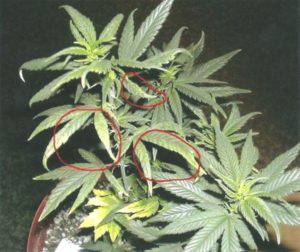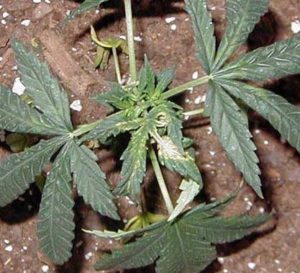
If your marijuana plant has a copper deficiency, this means simply that it doesn’t receive enough copper. This could be due to a lack of copper in its nutrients or something stopping it from accessing the normal amounts of nutrients.
Copper toxicity is when the plant has too much copper. This also means it is unable to use iron(Fe).
Signs of a copper deficiency
While copper deficiencies don’t occur very often, they can make a major impact on your crop when they do happen. You will first see it cropping up on the younger leaves, which will start to become discolored on their tips and margins.
They will have an odd, metallic glint to them of a copper-gray or blue-ish color. The flesh between the veins, however, will start turning yellow.
You might also notice curling or wilting of the leaves, which will eventually turn into complete leaf death. Although just seen in a few leaves at first, it could lead to a full wilting of the plant.
You will notice your plant having trouble with new growth, and the flowers in male marijuana plants won’t mature properly while females’ stigmas will exhibit abnormal growth.
With copper toxicity, on the other hand, the leaves will simply start to yellow, your plant’s roots will grow unnaturally large, and they will start decaying. This comes from your plant’s inability to utilize iron (Fe).
Not sure if your plants have a copper deficiency? Read the article Nutrient deficiencies in marijuana plants for a list with pictures of all deficiencies.
How to fix a copper deficiency
The first thing you should do if you think your plants may have a copper deficiency is to flush out everything with pH-balanced water that contain a mixture of nutrients. The pH level is extremely important. If your growing marijuana in soil, copper will be absorbed by your plant the best if it is at a pH level of between 6.0 and 7.0. In hydroponics systems, try going to a pH range between 5.5 and 6.0 instead.
To make sure that a copper deficiency or surplus doesn’t devastate your plants, you could try a product like Marijuana Booster to make sure your plants get a balanced serving of all the nutrients they need.
Another way of dealing with copper deficiency is to feed the foliage with copper fungicides. Copper fungicides include copper sulfate and chelated copper. Other natural substances that can help with copper deficiencies are greensand, kelp, and compost.
A more surprising option you might want to look into is actually soaking dimes or quarters in water, then feeding the plants with this water. This is because dimes and quarters are made up of almost all copper – 92%!
Don’t fret if the old abnormal growths don’t recover – new growths will form and will be healthy if you got rid of the copper deficiency problem.
List of marijuana plant symptoms
You can recognize a plant that has a copper deficiency differently, depending on whether the leaves are old or young. In younger leaves, the following symptoms may be exhibited:
Leaf Color:
– Darkened, twisted leaves
– Undertones of blue and/or purple
– Metallic glinting
Leaf Symptoms:
– Leaves curling under
– Tips that are turning yellow or white
In older leaves, on the other hand, you may instead see pale yellowing or the leaves turning white. Other symptoms you might see on the plant are:
Leaf Symptoms:
– New growths have trouble beginning to grow
Plant Symptoms:
– Lack of ripening in the buds or growth is very slow
– The female pistils are not growing regularly
– Limp, wilting plant and/or leaves
– General growth abnormalities
– Weakened stems
– Slow, twisted, or curling growing patterns
Almost all soil and water has a certain amount of copper at minimum, so it is quite rare that the deficiency comes from there. Instead, the issue most likely stems from a pH problem. When the pH isn’t balanced, your plants lose some of their ability to access nutrients.
Copper toxicity is also rare, but not to be ignored. If your plant receives too much copper, it could die very quickly. Make sure you are proactive when you suspect a copper problem!
Thank you readers for your interest in the article. Please like and comment so we have more motivation to write articles
Thank you readers for your interest in the article. Please like and comment so we have more motivation to write articles


0 Comment:
Post a Comment